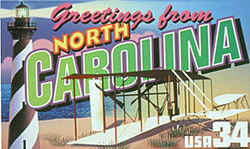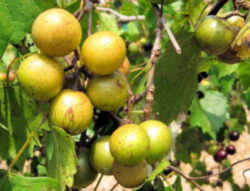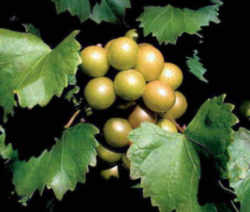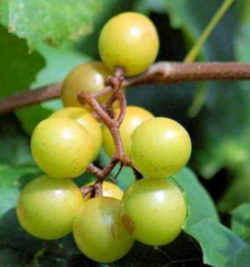
North Carolina Symbols
North Carolina State Fruit
Scuppernong Grape

(Genus Vitis)
Adopted on December 16, 2001.
The General Assembly of 2001 named the Scuppernong grape, (Genus Vitis,) as North Carolina official State Fruit (Session laws, 2001, c. 488). The same session law declared the strawberry and blueberry to be the state berries. A scuppernong is a large variety of muscadine (a type of grape native to southeastern U.S.). The grape was named after the Scuppernong River of North Carolina, where it was first discovered. The word Scuppernong is from the Algonquian Indian word ascopo which means "sweet bay tree."
North Carolina State Fruit: Scuppernong Grape

The first grape
to be actively cultivated in the United States, the Scuppernong is a variety of muscadine grape. It was named for the Scuppernong River, which runs
from Washington County to the Albemarle Sound. The Roanoke colonists are believed to have discovered the Scuppernong "Mother Vineyard," a vine that
is now over 400 years old and has a trunk more than two feet thick.
Grape cultivation is a small but growing part of the North Carolina economy. The value of the state's 2000 crop was over $2,600,000, up 17% from 1999.
The Scuppernong (Vitis rotundifolia) is a variety of muscadine grape, and has the distinction of being the first grape ever actively cultivated
in the United States. It was named for the Scuppernong River, which runs from Washington County to the Albemarle Sound. Giovanni de Verrazano noticed
this variety as far back as 1524, and explorers for Sir Walter Raleigh (or Ralegh, as it's sometimes spelled) in the 1580's sent back reports from
the Outer Banks of grape vines that "...covered every shrub and climbed the tops of high cedars. In all the world, a similar abundance was not to be
found." The Roanoke colonists are credited with discovering the Scuppernong "Mother Vineyard," a vine that is now over 400 years old and covers half
an acre.
Grape cultivation (of scuppernong and other varieties) is a small but growing part of the North Carolina economy. The value of the state's 2000 crop
was over $2,600,000, up 17% from 1999. According to the NC Department of Agriculture, there are 250 vineyards and 21 wineries located throughout the
state.
Scuppernong Grape
NCpedia
by Bland Simpson, 2006
 Scuppernong grape,
named the state fruit of North Carolina in 2001, is a bronze-green variety of the muscadine grape (Vitis rotundifolia). It is one of the best-known
names in North Carolina's (and the nation's) viticulture, being the first grape actively cultivated in the United States. Once also called the white
grape, the big white grape, and the Roanoke grape, the scuppernong gained popularity and noteworthiness as a wine grape on the south side of Albemarle
Sound. In 1811 it was named after Scuppernong River, Scuppernong Lake (now Lake Phelps), and the settlement of Scuppernong, all around Washington and
Tyrrell Counties. The word "scuppernong" comes from the Algonquian askuponong, meaning "place of the askupo," which is the sweet
bay tree (Magnolia virginiana). Old, variant spellings of the word include scoponum, coscoponum, cuetupcaning, skoupernong, and cascepunong.
Scuppernong grape,
named the state fruit of North Carolina in 2001, is a bronze-green variety of the muscadine grape (Vitis rotundifolia). It is one of the best-known
names in North Carolina's (and the nation's) viticulture, being the first grape actively cultivated in the United States. Once also called the white
grape, the big white grape, and the Roanoke grape, the scuppernong gained popularity and noteworthiness as a wine grape on the south side of Albemarle
Sound. In 1811 it was named after Scuppernong River, Scuppernong Lake (now Lake Phelps), and the settlement of Scuppernong, all around Washington and
Tyrrell Counties. The word "scuppernong" comes from the Algonquian askuponong, meaning "place of the askupo," which is the sweet
bay tree (Magnolia virginiana). Old, variant spellings of the word include scoponum, coscoponum, cuetupcaning, skoupernong, and cascepunong.
Samuel Huntington Perkins, a Yale graduate on his way to Lake Landing Plantation on the southeastern shore of Lake Mattamuskeet, arrived at Roanoke
Island in October 1817 and remarked in his diary, "The fig & grape here arrive to perfection. The inhabitants supply themselves with good
wine, but manufacture little or none for exportation." In June 1823 Thomas Jefferson ordered a 30-gallon barrel of "the pure juice of the
grape" through a Plymouth factor named Cox. In 1840 North Carolina was the premier winemaking state in America, its largest vineyard a six-acre
farm at Brinkleyville in Halifax County. Sixty years later another Halifax vintner, Paul Garrett, won a prize in Paris for scuppernong wine; in 1904
a sparkling scuppernong called Paul Garrett's Special Champagne took top honors at St. Louis's Louisiana Purchase Exposition. Within a few years, Garrett's
sweet Virginia Dare wine was among the most popular vinous drinks of the United States.
When Frank Hollowell of Bayside Plantation, Pasquotank County, put in scuppernongs there in 1973, he cited as his inspiration other up-and-coming growers
of that day such as the Wood family in Chowan County and the Sell family in Brunswick County (who perfected an absolutely dry scuppernong wine). Today
in Duplin County, the Fussell family operates Duplin Wine Cellars, vintners of a white scuppernong wine, a scuppernong blush, and a sparkling scuppernong
with a recipe "developed from an article written by Sidney Weller in 1853" and boasted "to be the oldest and best champagne produced
in America." These contemporary growers and vintners have all followed an old tradition, as North Carolina for the better part of two centuries
has been an American leader in utilizing its native grapes.
Act Adopting The Official Fruit and Berries of North Carolina.
PART I. NORTH CAROLINA'S HERITAGE OF FARMING
Whereas, North Carolina's economy originated and developed as an agrarian economy with a cornucopia of fruits and vegetables; and
Whereas, the State takes great pride in its rich heritage of farming; and
Whereas, there are still many families who base their livelihood in farming and who are continuing the North Carolina tradition of producing goods
from our land; and
Whereas, one of the main sources of agricultural production in the State is the production of fruits and berries of several varieties; and
PART II. THE SCUPPERNONG GRAPE.
Whereas, North Carolina is the home of our nation's first cultivated grape, the Scuppernong; and
Whereas, the Scuppernong grape was named after the Scuppernong River in North Carolina; and
Whereas, British explorers in 1584 and 1585 reported to Queen Elizabeth and Sir Walter Raleigh that the barrier islands of what is now, in part, Roanoke
Island were full of grapes and that the soil of the land was "so abounding with sweet trees that bring rich and most pleasant gummes, grapes of
such greatness, yet wild, as France, Spain, nor Italy hath not greater..."; and
Whereas, Sir Walter Raleigh's colony discovered the famous Scuppernong "Mother Vineyard" on Roanoke Island, a vine that is now over 400 years
old and has a trunk over two feet thick; and
Whereas, the State toast, penned in 1904, references North Carolina as the land "[w]here the scuppernong perfumes the breeze at night,";
and
PART III. THE STRAWBERRY AND THE BLUEBERRY.
Whereas, there are over 1,700 acres of strawberries and over 3,600 acres of blueberries harvested in North Carolina each year; and
Whereas, in 2000, strawberry growers in the State produced 23,000,000 pounds of strawberries, yielding $17,325,000 in revenues; and
Whereas, in 2000, blueberry growers in the State produced 17,500,000 pounds of blueberries, resulting in an increase in the State's economy of over
$18,000,000 in revenues; and
Whereas, these delicious berries are a good source of vitamins, a number of life sustaining minerals, and dietary fiber;
Whereas, the blueberry is an antioxidant, which has been proven to reduce cholesterol and lower the risk of heart disease; and
Whereas, each year the Town of Chadbourn in Columbus County hosts the North Carolina Strawberry Festival, which is one of the most celebrated traditions
in the State; and
Whereas, the State of North Carolina does not have an official fruit nor an official berry; Now, therefore,
The General Assembly of North Carolina enacts:
SECTION 1. Chapter 145 of the General Statutes is amended by adding a new section to read:
"§145-18. State fruit and State berries.
(a) The official fruit of the State of North Carolina is the Scuppernong grape (Vitis genus).
(b) The official red berry of the State is the strawberry (Fragaria genus).
(c) The official blue berry of the State is the blueberry (Vaccinium genus)."
SECTION 2. This act is effective when it becomes law.
In the General Assembly read three times and ratified this the 5th day of December, 2001.
s/ Beverly E. Perdue
President of the Senate
s/ James B. Black
Speaker of the House of Representatives
s/ Michael F. Easley
Governor
Approved 6:58 p.m. this 16th day of December, 2001
North Carolina Law
The law designating the Scuppernong grape as the official North Carolina state fruit is found in the North Carolina General Statutes, Chapter 145 Section 145-18
Chapter 145 - State Symbols and Other Official Adoptions.
Section 145-18.
§ 145-18. State fruit and State berries.
(a) The official fruit of the State of North Carolina is the Scuppernong grape (Vitis genus).
(b) The official red berry of the State is the strawberry (Fragaria genus).
(c) The official blue berry of the State is the blueberry (Vaccinium genus).
(2001-488, s. 1.)
Taxonomic Hierarchy: Scuppernong Grape
Kingdom: Plantae - Plants
Subkingdom: Tracheobionta - Vascular plants
Superdivision: Spermatophyta - Seed plants
Division: Magnoliophyta - Flowering plants
Class; Magnoliopsida - Dicotyledons
Subclass; Rosidae
Order: Rhamnales
Family: Vitaceae - Grape family
Genus: Vitis L. - grape
Species: *

List Official US State Foods






